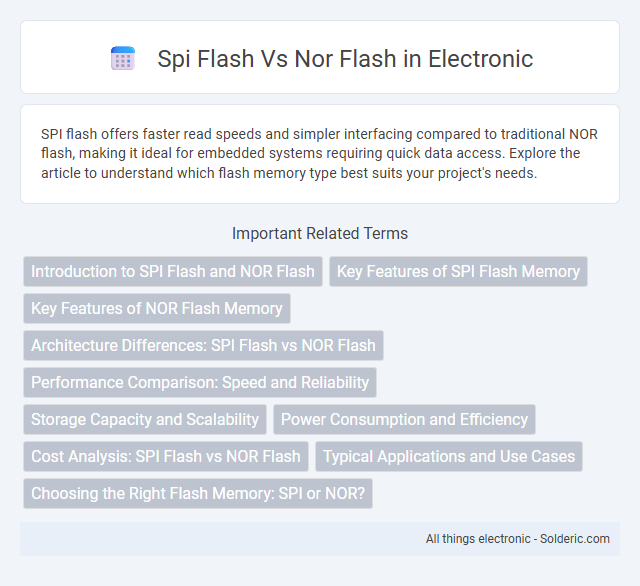SPI flash offers faster read speeds and simpler interfacing compared to traditional NOR flash, making it ideal for embedded systems requiring quick data access. Explore the article to understand which flash memory type best suits your project's needs.
Comparison Table
| Feature | SPI Flash | NOR Flash |
|---|---|---|
| Interface | Serial Peripheral Interface (SPI) | Parallel interface |
| Speed | Higher read/write speed due to serial data transfer | Slower than SPI in general |
| Capacity | Typically up to 512MB or more | Usually smaller, up to 128MB |
| Cost | Lower cost, cost-effective for large storage | Higher cost per MB |
| Read Access | Fast serial read, good for data streaming | Random access possible, suitable for executing code |
| Write/Erase Cycles | Typically 10,000 to 100,000 cycles | Similar endurance, varies by vendor |
| Usage | Mass storage, boot code, firmware updates | Code execution in place (XIP), BIOS storage |
| Power Consumption | Lower during read/write | Generally higher |
| Density | Higher density chips available | Lower density, optimized for reliability |
Introduction to SPI Flash and NOR Flash
SPI Flash and NOR Flash are types of non-volatile memory used for storage in embedded systems. SPI Flash uses a Serial Peripheral Interface for high-speed communication and compact design, making it ideal for applications requiring fast read/write access and low pin count. NOR Flash offers faster read speeds and random access capability, suitable for executing code directly from memory in microcontrollers and other devices.
Key Features of SPI Flash Memory
SPI flash memory features fast read speeds, low pin count interface, and simple serial communication, making it ideal for embedded systems. It supports high-density storage with reliable data retention and offers flexible sector-based erase operations. Compared to NOR flash, SPI flash provides a more compact form factor with cost-effective scalability for applications requiring efficient memory access.
Key Features of NOR Flash Memory
NOR flash memory offers fast random data access and reliable execute-in-place (XIP) functionality, making it ideal for code storage and direct memory execution. It features high endurance with millions of program/erase cycles and robust data retention lasting up to 20 years. NOR flash employs parallel data access and supports byte-level erasure, providing precise and efficient memory management for embedded systems and firmware applications.
Architecture Differences: SPI Flash vs NOR Flash
SPI flash utilizes a serial interface with a simple, low-pin-count design optimized for fast data transfers and compact footprints, whereas NOR flash employs a parallel architecture with a larger pin count enabling direct byte-level random access. The serial communication in SPI flash results in slower access times but reduced complexity, while NOR flash's parallel structure provides faster read speeds and execute-in-place (XIP) capabilities. Architecturally, NOR flash stores data in a grid of memory cells connected to bit and word lines for parallel access, contrasting with SPI flash's reliance on serial data streams controlled by a shift register mechanism.
Performance Comparison: Speed and Reliability
SPI flash memory offers faster read and write speeds compared to traditional NOR flash, making it ideal for applications requiring quick data access and efficient programming. NOR flash excels in reliability with superior endurance and lower bit error rates, ensuring stable performance in critical embedded systems. The choice between SPI and NOR flash depends on balancing the need for speed in SPI versus the robustness and long-term reliability inherent to NOR technology.
Storage Capacity and Scalability
SPI Flash typically offers lower storage capacity compared to NOR Flash, with SPI Flash commonly available in sizes up to 256MB, while NOR Flash can scale beyond 1GB, catering to more demanding storage needs. Your choice between SPI and NOR Flash should consider not only current capacity requirements but also future scalability, as NOR Flash's architecture supports larger memory arrays and more extensive code storage. Scalability in NOR Flash enables better performance in executing code directly from memory, making it ideal for embedded systems requiring high-capacity, reliable non-volatile storage.
Power Consumption and Efficiency
SPI flash memory typically exhibits lower power consumption compared to NOR flash due to its simpler serial interface and smaller die size, making it more efficient for battery-powered and portable devices. NOR flash, while offering faster random access speeds and execute-in-place (XIP) capabilities, generally consumes more power, especially during read and write operations. Optimizing power efficiency in embedded systems often involves choosing SPI flash for non-volatile storage where low energy use is critical.
Cost Analysis: SPI Flash vs NOR Flash
SPI flash generally offers a more cost-effective solution compared to NOR flash, making it ideal for applications requiring higher storage capacity at lower prices. NOR flash features faster read speeds and better execute-in-place (XIP) capabilities but comes at a higher cost due to its complex architecture. Your choice depends on balancing budget constraints with performance needs, where SPI flash typically provides superior value for large memory storage.
Typical Applications and Use Cases
SPI flash is commonly used in embedded systems, microcontrollers, and IoT devices due to its fast read speeds and compact physical size, making it ideal for firmware storage and boot code. NOR flash is favored in applications requiring execute-in-place (XIP) capability and high reliability, such as automotive ECUs, industrial control systems, and communication equipment. Both types serve critical roles in consumer electronics, but SPI flash is preferred for cost-sensitive mass production, while NOR flash suits mission-critical applications with stringent endurance and data retention requirements.
Choosing the Right Flash Memory: SPI or NOR?
Choosing between SPI flash and NOR flash depends on your device's speed, density, and cost requirements. SPI flash offers higher data transfer rates and is cost-effective for large storage in consumer electronics, whereas NOR flash provides faster random access and better reliability for code execution in embedded systems. Understanding your application's read-write patterns and endurance needs ensures optimal flash memory selection for performance and durability.
spi flash vs nor flash Infographic

 solderic.com
solderic.com